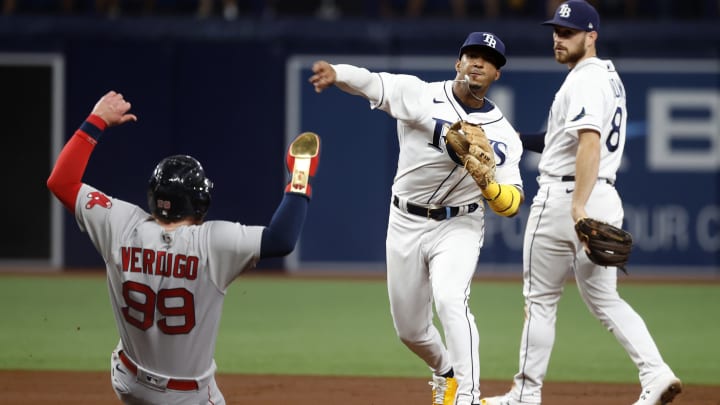Rays' Attention to Detail Shines as Defensive Positioning Pays Dividends

Welcome to The Opener, where every weekday morning you’ll get a fresh, topical column to start your day from one of SI.com’s MLB writers.
There was no question about the most transcendent moment of the Rays’ 5–0 win over the Red Sox in Game 1 of the ALDS. It was Tampa Bay left fielder Randy Arozarena in a dazzling reprisal of his role as playoff hero—pulling off a straight steal of home in the seventh inning, the kind of thrilling play that is made for October, done with the precision and attention to detail that typically characterize the Rays.
But some of the team’s sharpest work in the shutout came from a routine attribute that is far less sexy—its defensive positioning.
The Red Sox made a fair amount of hard contact Thursday night. But much of it died in the infield. After the game, Rays manager Kevin Cash ran over the fates of some of the hardest-hit balls, with one snagged by his second baseman Brandon Lowe, another by shortstop Wander Franco and one more by third baseman Yandy Diaz. All had looked easy—casual, even. How? As has been a strength of this team all year, each of these fielders knew to get set up in juuust the right place.

“If you’re not in the right position,” Cash said, “you’re not getting to those balls, let alone catching them.”
It’s not that the Rays deploy the shift especially often: They’re almost exactly league-average, in fact, with 55.6% of their pitches thrown in front of a defense that does not have any kind of official strategic alignment. (The MLB average this year was 56.5%.) But they are masterful at adjusting where they stand without fully shifting their positions. These moves can be subtle—almost imperceptible in some cases—but they consistently pay off. It doesn’t matter who is at the plate. Tampa Bay almost always seems to get in the right place at the right time.
“Our guys upstairs, they kind of give us the blueprint of ‘This is where they hit the ball most on these types of pitches and these types of match-ups,’” Cash said of what the front office provides his coaching staff. “We’re fortunate that we’ve got guys that really care, pay attention to every little detail. Any advantage that can help us, we’re going to try to use. And it was fitting that it showed up tonight.”
This positioning on Thursday night was a boon to rookie starter Shane McClanahan. The 24-year-old lefty rose to the occasion with some flashes of downright nasty stuff. (This was particularly true in the first inning, when he got three swinging strikeouts with three different out-pitches, including a triple-digit heater.) But he still allowed a fair amount of hard contact over the course of the night—eight hitters recorded an exit velocity of 98 mph or greater off McClanahan. Yet that translated to very little damage. Just two of those hard-hit balls turned into hits. All the others? The Rays’ gloves were ready and waiting. (And each of those two hits was a single: Even when Boston could get a ball to drop, Tampa Bay’s fielders were never too far off.) This meant that the Red Sox had several good opportunities to get on base versus McClanahan. But the Rays’ precise positioning ensured that nothing came of any of them.
“As an offense, I thought we did a good job of getting our knocks,” said Red Sox second baseman Christian Arroyo. “We just didn’t have that gut-punching blow.”
Of course, Tampa Bay’s defense is more than its positioning. It’s also just plain good: It was second in defensive efficiency in the American League this season only to Houston, with fewer errors than the league average, and several players who individually topped positional leaderboards. (By comparison, defense is something of a shortcoming for Boston, who led the AL in errors with 108.) But the Rays’ positioning makes all of that defensive success possible—tiny steps that, quite literally, add up.
This was far from the flashiest part of the night. Even before his steal, Arozarena picked up right where he left off last October with a solo home run in the fifth inning. Franco became the youngest player in history to record multiple hits in his postseason debut. (Would you expect anything else from him?) The team as a whole did an excellent job of exploiting Boston’s weaknesses by getting to its lackluster bullpen early. But the obvious success of defensive positioning in their first playoff game of the year felt like something of a harbinger for the Rays: The little stuff can matter quite a lot in October. And there might not be any team in baseball that has made such a habit of nailing the little stuff as has Tampa Bay—even when it means going one step at a time.
More MLB Coverage:
• The Yankees Are Simply a Step Behind
• Welcome to the Updated Version of Playoff Baseball
• MLB Roundtable: Who's Going to Win the World Series?
• Lance 'MacGyver' McCullers Jr. Is Emerging as a True Postseason Ace
